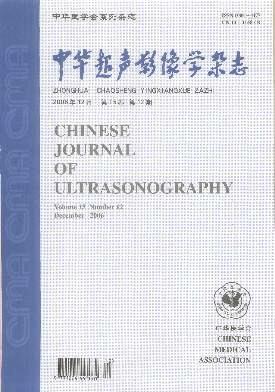The clinical value of ultrasound in the assessment of the severity of COVID-19
Q4 Medicine
引用次数: 1
Abstract
Objective: To summarize the ultrasound manifestations of lung lesions in patients with coronavirus disease 2019 (COVID-19), and explore the clinical value of ultrasonography in assessing the severity of the disease Methods: Thirty-one patients with COVID-19 admitted to the Fifth Affiliated Hospital of Sun Yat-sen University from January 18 to February 5, 2020, were selected as the research subjects All of them underwent dynamic lung ultrasound Their lung lesions were observed, and the lung ultrasound score (LUS) was performed, respectively The correlations between the LUS and the disease classification, the LUS and the blood oxygenation index (PaO2/FiO2) were analyzed, respectively The relationship between the corresponding change of clinical classification and the LUS score when it progressed to moderate/severe was analyzed as well Results: Among the 31 patients with COVID-19, two (6 5%) had no apparent lesions at the ultrasound, with the LUS score of 0 Twenty-nine (93 5%) showed abnormities at the ultrasound, with the LUS score from 1-26, and the main manifestations were B-line signs Among them 6 (19 4%) had the "white lung signs", and 13 (41 9%) had pulmonary consolidations The LUS score was positively correlated with the clinical classification (rs=0 683 2, P<0 001) and negatively correlated with PaO2/FiO2 (r=-0 864 3, P<0 001) In the initial and dynamic ultrasonography, 13 patients were graded as moderate/severe according to their LUS scores, and the accuracy of the LUS in assessing severe/critical patients was 81 3% (13/16) It was 1-3 days earlier for the LUS progressing to moderate/severe than clinical classification Conclusions: Pulmonary ultrasound manifestations of patients with COVID-19 have specific characteristics mainly showing as lung interstitial lesions, which can be combined with pulmonary consolidation Ultrasound can be used in the assessment of the severity of COVID-19 noninvasively and guide clinical treatment © 2020 Chinese Medical Association超声在评估新冠肺炎严重程度中的临床价值
目的:总结2019冠状病毒病(COVID-19)患者肺部病变的超声表现,探讨超声在评估疾病严重程度中的临床价值。选取2020年1月18日至2月5日中山大学附属第五医院收治的31例新冠肺炎患者作为研究对象,所有患者均行动态肺超声检查,观察肺病变,分别进行肺超声评分(LUS),分析LUS与疾病分型、LUS与血氧合指数(PaO2/FiO2)的相关性。分别分析进展到中度/重度时临床分型的相应变化与LUS评分的关系。31 COVID-19患者中,两个(6 5%)没有明显病变超声,0的逻辑单元得分29(93 5%)在超声显示异常,与逻辑单元从1-26分数,和它们之间的主要表现是变址寄存器迹象6(19 4%)有“白肺”迹象,13(41 9%)和肺合并逻辑单元分数呈正相关,临床分类(rs = 0 683 2, P < 0 001)和与PaO2 /供给负相关(r = 0 864 3,P< 0.001)在初始和动态超声检查中,13例患者根据LUS评分分为中/重度,LUS对重/危重患者的评估准确率为83% (13/16),LUS进展为中/重度的时间比临床分级早1-3天。新型冠状病毒肺炎患者的肺部超声表现具有特异性,主要表现为肺间质病变,可与肺实变相结合,超声可用于无创评估新型冠状病毒肺炎的严重程度,指导临床治疗©2020中华医学会
本文章由计算机程序翻译,如有差异,请以英文原文为准。
求助全文
约1分钟内获得全文
求助全文
来源期刊

中华超声影像学杂志
Medicine-Radiology, Nuclear Medicine and Imaging
CiteScore
0.80
自引率
0.00%
发文量
9126
期刊介绍:
 求助内容:
求助内容: 应助结果提醒方式:
应助结果提醒方式:


